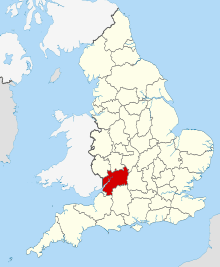Gloucester Cathedral
| Gloucester Cathedral | |
|---|---|
|
Cathedral Church of St Peter and the Holy and Indivisible Trinity | |
 | |
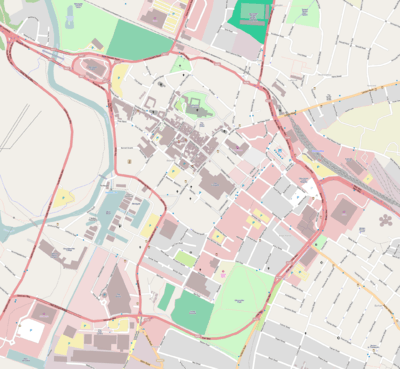 Gloucester Cathedral Shown within Gloucester | |
| Coordinates: 51°52′03″N 2°14′48″W / 51.8675°N 2.246667°W | |
| Location | Gloucester, Gloucestershire |
| Country | United Kingdom |
| Denomination | Church of England |
| Website |
gloucestercathedral |
| Architecture | |
| Style | Romanesque & Gothic |
| Years built | 1089–1499 |
| Specifications | |
| Length | 130m |
| Nave length | 174ft (53m) [1] |
| Choir length | 140ft (42m) [1] |
| Nave width | 34ft (10m) [1] |
| Width across transepts | 43.9m |
| Height | 68.6m |
| Nave height | 68ft (21m) [1] |
| Choir height | 86ft (26m) [1] |
| Number of towers | 1 |
| Tower height | 68.6m |
| Administration | |
| Diocese | Gloucester (since 1541) |
| Province | Canterbury |
| Clergy | |
| Dean | Stephen Lake |
| Precentor | Richard Mitchell |
| Canon(s) | Nikki Arthy (City Rector) |
| Canon Pastor | Celia Thomson |
| Canon Missioner | Andrew Braddock (DMM) |
| Archdeacon | Jackie Searle |
| Laity | |
| Director of music | Adrian Partington |
| Organist(s) | Jonathan Hope |
| Chapter clerk | Emily Shepherd (COO) |
Gloucester Cathedral, formally the Cathedral Church of St Peter and the Holy and Indivisible Trinity, in Gloucester, England, stands in the north of the city near the River Severn. It originated in 678 or 679 with the foundation of an abbey dedicated to Saint Peter (dissolved by Henry VIII).
History
Foundations
Wardle records that in 1058 Ealdred, Bishop of Worcester at the time, rebuilt the church of St Peter.[2] The foundations of the present church were laid by Abbot Serlo (1072–1104). Walter Frocester (d. 1412) the abbey's historian, became its first mitred abbot in 1381.[3] Until 1541, Gloucester lay in the see of Worcester, but the separate see was then constituted, with John Wakeman, last abbot of Tewkesbury, as its first bishop. The diocese covers the greater part of Gloucestershire, with small parts of Herefordshire and Wiltshire. The cathedral has a stained glass window containing the earliest images of golf. This dates from 1350, over 300 years earlier than the earliest image of golf from Scotland.[4] There is also a carved image of people playing a ball game, believed by some to be one of the earliest images of medieval football.
Construction and architecture

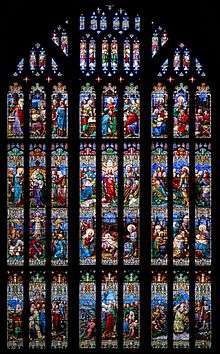

The cathedral, built as the abbey church, consists of a Norman nucleus (Walter de Lacy is buried there), with additions in every style of Gothic architecture. It is 420 feet (130 m) long, and 144 feet (44 m) wide, with a fine central tower of the 15th century rising to the height of 225 ft (69 m) and topped by four delicate pinnacles, a famous landmark. The nave is massive Norman with an Early English roof; the crypt, under the choir, aisles and chapels, is Norman, as is the chapter house. The crypt is one of the four apsidal cathedral crypts in England, the others being at Worcester, Winchester and Canterbury.
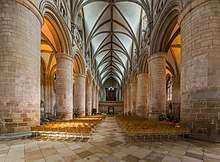
The south porch is in the Perpendicular style, with a fan-vaulted roof, as also is the north transept, the south being transitional Decorated Gothic. The choir has Perpendicular tracery over Norman work, with an apsidal chapel on each side: the choir vaulting is particularly rich. The late Decorated east window is partly filled with surviving medieval stained glass. Between the apsidal chapels is a cross Lady chapel, and north of the nave are the cloisters, the carrels or stalls for the monks' study and writing lying to the south. The cloisters at Gloucester are the earliest surviving fan vaults, having been designed between 1351 and 1377 by Thomas de Canterbury.[5]
The most notable monument is the canopied shrine of Edward II of England who was murdered at nearby Berkeley Castle (illustration below). The building and sanctuary were enriched by the visits of pilgrims to this shrine. In a side-chapel is a monument in coloured bog oak of Robert Curthose, eldest son of William the Conqueror and a great benefactor of the abbey, who was interred there. Monuments of William Warburton (Bishop of Gloucester) and Edward Jenner (physician) are also worthy of note.
Between 1873 and 1890, and in 1897, the cathedral was extensively restored by George Gilbert Scott.
Recent construction
In September 2016 Gloucester Cathedral joined the Church of England’s ‘Shrinking the Footprint’ campaign. The aim of this campaign is to reduce The Church of England’s carbon emissions collectively, by 80%. In order to help reach this target Gloucester Cathedral commissioned local solar company Mypower to install an array on the nave of Gloucester Cathedral. Purportedly the solar array will reduce Gloucester Cathedral’s energy costs by 25%.[6] The installation was completed by November 2016. The 1000 year old Cathedral is now the oldest building in the world to have undergone a solar installation.
Misericords
The cathedral has forty-six 14th-century misericords and twelve 19th-century replacements by Gilbert Scott. Both types have a wide range of subject matter: mythology, everyday occurrences, religious symbolism and folklore.
Dean and chapter
As of 11 January 2018:[7]
- Dean — Stephen Lake (since 12 June 2011 installation)
- Canon Precentor & Director of Congregational Development — Richard Mitchell (since 10 September 2016 installation)[8]
- Canon Pastor — Celia Thomson (since 15 March 2003 installation)[9]
- City Centre Rector (Canon Residentiary) — Nikki Arthy (since 2009)
- Archdeacon of Gloucester (Canon Residentiary) — Jackie Searle (since 12 September 2012 collation)
- Director of Mission and Ministry (Canon Residentiary) — Andrew Braddock (since 2 February 2013 installation)[10]
Music
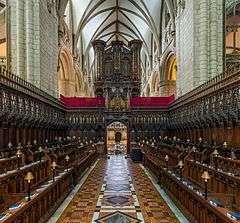
Organ
The organ was originally constructed in 1666 by Thomas Harris and has the only complete 17th-century cathedral organ case surviving in the country. The pipes displayed on the front of the case are still functional. The organ was extended and modified by nearly all of the established UK organ builders, including Henry "Father" Willis who worked on the organ in 1847 and rebuilt it in 1888-9.[11] It was rebuilt again in 1920 by Harrison & Harrison.[12]
In 1971 Hill, Norman and Beard performed a total redesign, under the supervision of Cathedral Organist John Sanders and consultant Ralph Downes. In 1999 Nicholson & Co overhauled the organ, when the soundboards, pipework and wind supply were renovated and the computer system was updated. In 2010 Nicholson also added a Trompette Harmonique solo reed.[12]
The organ comprises four manuals and pedals. It is designed particularly to play from its position on the Quire screen to both East and West sides of the Cathedral. The Swell is situated in the centre of the case at console level and is controlled by two swell pedals, one for each side of the case. Directly above the Swell is the Great organ which is split into East and West divisions; it comprises two separate principal choruses. The fourth manual is a West Positive, mirroring the function of the Choir organ for the West side of the Cathedral.[12]
Organists
In 1582, Robert Lichfield is recorded as the organist of Gloucester Cathedral. Notable among the organists are composers and choral conductors of the Three Choirs Festival, Herbert Brewer, Herbert Sumsion and John Sanders. Herbert Howells, who was a pupil of Brewer, composed a Magnificat and Nunc dimittis for Gloucester Cathedral
Three Choirs Festival
An annual musical festival, the Three Choirs Festival, is hosted by turns in this cathedral and those of Worcester and Hereford in rotation.[13] The Three Choirs is the oldest annual musical festival in the world.
Clock and bells
Clock
The Cathedral's clock, bells and the chimes are referred to in a repair agreement of 1525. The present clock, installed in 1898, is by Dent and Co, who built the clock for Big Ben. There is no external dial, but there is a fine Art Nouveau clock face in the north transept, dating from 1903, designed by Henry Wilson.
Bells
The bells were rehung and augmented in 1978 to give a ring of twelve. The two oldest bells date from before 1420, so they are older than the present tower. The bells are rung 'full circle' by the Cathedral's band of ringers for the weekly practice session In addition there is Great Peter, the largest medieval bell in Britain, weighing a fraction under three tons. Great Peter is the hour bell and can also be heard ringing before the main services.
Burials and monuments
Gloucester Cathedral has a large collection of funerary monuments from the Middle Ages to the present. Notable people buried at Gloucester Cathedral include:
- Osric, king of the Hwicce
- Robert Curthose, eldest son of William the Conqueror
- Edward II of England, seventh Plantagenet king of England (1307–1327)
- John Wakeman, last Abbot of Tewkesbury and first Bishop of Gloucester (1541–1550)
- James Brooks Bishop of Gloucester (1554–1558)
- Richard Cheyney, Bishop of Gloucester (1562–1579)
- John Bullingham, Bishop of Gloucester (1581–1598)
- Members of the Hyett family from the 17th and 18th centuries, whose remains were discovered accidentally in November 2015.[14]
- William Nicholson Bishop of Gloucester (1660–1672)
- Martin Benson, Bishop of Gloucester (1734–1752)
- Richard Pate, landowner and Member of Parliament for Gloucester
- Thomas Machen, mercer who was mayor of Gloucester three times and one time Member of Parliament for the city
- Dorothea Beale, Principal of the Cheltenham Ladies' College, educational reformer and suffragist
- Ralph Bigland (1712–1784), Garter Principal King of Arms
- Miles Nightingall (1768–1829), army general
- Albert Mansbridge (1876–1952), pioneer of adult education in Britain
- John Yates (1925–2008), Bishop of Gloucester 1975–1992
 Tomb of Osric, king of the Hwicce
Tomb of Osric, king of the Hwicce- Tomb of Robert Curthose
 Tomb of Thomas Machen
Tomb of Thomas Machen- Tomb of Edward II of England
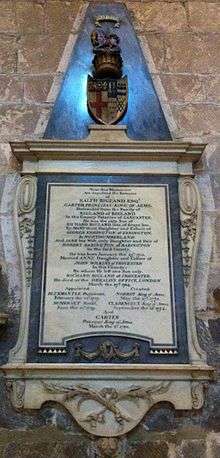 Memorial to Ralph Bigland
Memorial to Ralph Bigland Memorial to Mary Clarke
Memorial to Mary Clarke- Memorial to John Stafford Smith
- Grave of Albert Mansbridge
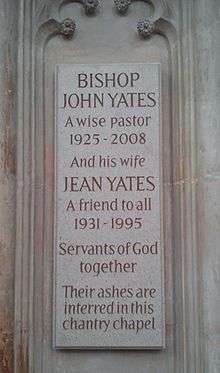 Memorial to John Yates
Memorial to John Yates
Film and TV location
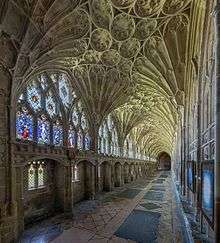
- Harry Potter
- The cathedral was used as a location for filming the first, second and sixth Harry Potter films.
- Doctor Who
- In 2008, the cathedral was used by BBC Wales as a location for the Doctor Who Christmas special.[15][16]
- The Hollow Crown
- The cathedral was used as a filming location in the BBC's series The Hollow Crown (an adaption of Shakespeare's Henry IV parts 1 and 2).[17]
- Wolf Hall
- Sherlock
Academic use
Degree ceremonies of the University of Gloucestershire and the University of the West of England (through Hartpury College) both take place at the cathedral.[21][22]
The cathedral is also used during school term-time as the venue for assemblies (known as morning chapel) by The King's School, Gloucester, and for events by the High School for Girls (Denmark Road, Gloucester), the Crypt Grammar School for boys and Ribston Hall High School.
Timeline
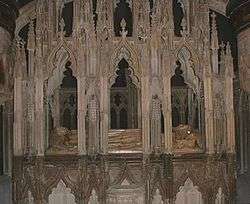
- 678-9 A small religious community was founded in Saxon times by Osric of the Hwicce. His sister Kyneburga was the first abbess.
- 1017 Secular priests expelled; the monastery given to Benedictine monks.
- 1072 Serlo, the first Norman abbot, appointed to the almost defunct monastery by William I.
- 1089 Foundation stone of the new abbey church laid by Robert de Losinga, Bishop of Hereford.
- 1100 Consecration of St Peter’s Abbey.
- 1216 First coronation of Henry III.
- 1327 Burial of Edward II.
- 1331 Perpendicular remodelling of the quire.
- 1373 Great Cloister begun by Abbot Horton; completed by Abbott Frouster (1381–1412)
- 1420 West End rebuilt by Abbot Morwent.
- 1450 Tower begun by Abbot Sebrok; completed by Robert Tully.
- 1470 Lady Chapel rebuilt by Abbot Hanley; completed by Abbot Farley (1472–98).
- 1540 Dissolution of the abbey.
- 1541 Refounded as a cathedral by Henry VIII.
- 1616–21 William Laud holds the office of Dean of Gloucester
- 1649–60 Abolition of dean and chapter, reinstated by Charles II
- 1735–52 Martin Benson, Bishop of Gloucester, carried out major repairs and alterations to the cathedral.
- 1847–73 Beginning of extensive Victorian restoration work (Frederick S. Waller and George Gilbert Scott, architects).
- 1953 Major appeal for the restoration of the cathedral; renewed
- 1968 Cathedral largely re-roofed and other major work completed.
- 1989 900th anniversary appeal.
- 1994 Restoration of tower completed.
- 2000 Celebration of the novecentennial of the consecration of St Peter’s Abbey.
See also
Notes
- 1 2 3 4 5
- ↑ Wardle, Terry Heroes & Villains of Worcestershire 2010 The History Press, Stroud, Gloucestershire p. 10 ISBN 978-0-7524-5515-0
- ↑ Gransden, Antonia (2013). Historical Writing in England: 550 - 1307 and 1307 to the Early Sixteenth Century. Routledge. p. 391.
- ↑ "The first Golf record?". A Royal and Ancient Golf History video. Fore Tee Video. Archived from the original on 22 January 2009. Retrieved 16 January 2009.
- ↑ Harvey, John (1978). The Perpendicular Style. Batsford. ISBN 0-7134-1610-6.
- ↑ "Let there be light - 1000 year old Gloucester Cathedral becomes the oldest building of its type in the world to install solar PV". MyPower.com. Retrieved 7 September 2018.
- ↑ "Gloucester Cathedral - Cathedral Chapter". Gloucestercathedral.org.uk. Retrieved 7 September 2018.
- ↑ "Crown Appoints Canon Precentor". Gloucester.anglican.org. Retrieved 7 September 2018.
- ↑ "Christ Church West Wimbledon — Information, Candlemas 2003" (PDF). Christchurch-westwimbledon.org.
- ↑ "Church Times gazette". Church Times. p. 58. #7814.
21/28 December 2012
- ↑ "The National Pipe Organ Register". Npor.org.uk. Retrieved 7 September 2018.
- 1 2 3 "Gloucester Cathedral - Organ". Gloucestercathedral.org.uk. Retrieved 12 December 2016.
- ↑ "Three Choirs Festival". Retrieved 16 January 2009.
- ↑ "Burial vault discovered 'accidentally' at Gloucester Cathedral". BBC News. 2 November 2015. Retrieved 2 November 2015.
- ↑ "Gloucester Cathedral 'should be heritage site'". Bbc.co.uk. January 2014. Retrieved 7 September 2018.
2008 the cathedral was used by BBC Wales as a location for the Doctor Who Christmas special.
- ↑ "Gloucester on film". Thecityofgloucester.co.uk.
- ↑ "IT was a case of 'once more into the breach' for Gloucester Cathedral which has provided the backdrop for another star studded drama". Thisisgloucestershire.co.uk. 20 January 2012. Archived from the original on 5 May 2013. Retrieved 12 December 2016.
- ↑ "The stately homes of Wolf Hall". Bbc.co.uk. 7 September 2018. Retrieved 7 September 2018.
- ↑ "Sherlock watch: Benedict Cumberbatch and Martin Freeman set for filming in Gloucester Cathedral". Gloucester Citizen. 22 January 2015. Retrieved 23 January 2015.
- ↑ "Sherlock stars back filming at Gloucester Cathedral today". Gloucester Citizen. 23 January 2015.
- ↑ "Information for the Ceremonies held at Gloucester Cathedral". University of Gloucestershire. Archived from the original on 20 October 2011. Retrieved 4 May 2012.
- ↑ "Higher Education Graduation". Hartpury College. Archived from the original on 20 March 2012. Retrieved 4 May 2012.
References
- Simmons, D A (1962). Who's who in music and musicians' international directory (4th. ed.). London: Burke's Peerage Ltd. OCLC 13309419. Published in America as Simmons, David (1962). Who's who in music and musicians' international directory (4th. ed.). New York: Hafner Publishing Company. OCLC 12923270.
External links
| Wikimedia Commons has media related to Gloucester Cathedral. |

